Everyone loves saving money, so it might be tempting to offer discounts on online courses regularly. Even psychological studies prove that people get a boost of oxytocin, the “feel-good” hormone when they receive a coupon.
While that’s true, there is also a downside to offering discounts. Many online courses seem to be on sale all the time, sometimes up to 80% less, but this can do more harm than good. As a course creator, if your competition offers discounts all year round, you might feel the pressure to reduce your rates as well. However, very low prices, such as $10 instead of $100 might make people perceive your courses as being less valuable than they actually are.
No matter where you are in your course entrepreneurship journey, you need to figure out the best way to navigate discounts without selling yourself short. So, should you offer discounts? When should you price down courses? How much should you take off the initial price?
Keep reading to find an answer to all those questions and more.
Why offer discounts on online courses?
Offering discounts can be an excellent way to acquire new learners as well as motivate current ones to purchase again from you. However, it’s important to have the right planning if you want to build customer loyalty in the long run. Here are a few reasons to offer discounts on online courses.
Create a sense of urgency
Since you spend so much time working and perfecting your online course, it would be a good idea to offer a limited-time discount for people who purchase it during a certain timeframe. This will make learners curious about your newly-launched course and might increase your chances of turning them into loyal customers.
Reward loyal learners
By offering a coupon or a bulk discount to your loyal learners, you make them feel appreciated. For example, if there are learners that have purchased at least two of your courses, it’s time to come up with a reward program for them.
Bulk discounts that apply to the whole cart are an excellent way to give a little token back. Ten percent might not seem like a lot, but it can make a big difference when purchasing multiple items. Another thing that you could do is to create special bundles for them and sell them as a package.
Generate repeat purchases
How many times have you purchased an item online and received a discount code to use on the same website? Probably many times. This is one of those strategies that everyone uses, from small to large companies, and it works great.
While subscriptions are ideal as they ensure that your learners will return for more, offering a small coupon will have the same effect. Next time your learners purchase your courses, you can send them a thank you message and include a promotional code. If you want to be sure they’ll purchase another one of your courses, you can offer a 20-30% discount code for a limited time.
Are there any disadvantages to offering discounts on online courses?
Although offering discounts on online courses seems to be a no-brainer for increasing your revenue and brand awareness, there are also potential downsides. Here are a few examples:
Potential brand damage
People often associate high prices with good quality products. Even if you can’t afford a $2,000 pair of designer sneakers, you still perceive them as high quality. The same applies to your online courses.
In this case, your learners believe that they get what they pay for. If they see that you now sell courses for $10 instead of $100, they will believe that something is off about the content of those courses. I’m not suggesting that your prices should be extortionate just so you can compare with famous course creators, but it’s best to offer discounts less often if you want to maintain a valued brand image.
Lower profit
Many course creators might believe that lowering course prices is the best way to increase sales and keep their existing learners. This is not entirely true. However, some hidden effects are associated with lowering your prices. The most common one is related to a decrease in your profit.
If you decide to cut your cost by 10%, so you start selling a bundle for $90 instead of $100, you will have to sell more courses to make a profit. This is a significant negative effect on your business. As previously mentioned, you cannot expect to get a burst of learners just because you have lowered your prices. After all, your competition might do that, too.
Meaningless discount
You have probably seen a particular brand or even a competitor that always offers discounts on online courses. No matter the season or occasion, they send a newsletter reminding you of the great deal they currently have.
However, the more they do that, the bigger the chance that people get used to those sales and don’t believe they are accurate anymore. Therefore, when it comes to the online courses you spend so much time perfecting, it’s good to take your time and only offer discounts in important moments.
In one of the examples above, I was talking about offering deals for a new course launch. It’s a great opportunity to increase your customer lifetime value and send them a discount code.
How to figure out how many discounts to offer?
Offering discounts on online courses can be beneficial for your business as you don’t lose money while doing so. Creating online courses takes a big initial investment, but they don’t need a lot of money to be maintained so that you can offer them at low discounts. The higher the discount you offer, the more difficult it is to cover the initial investment.
For instance, a 10% discount is a nice reward for some existing learners, but that’s not enough to attract new people. You can increase profits by using the bundle option in your learning platform. How? Firstly, by applying this strategy, you increase the number of courses or digital media files you sell. Secondly, you’re able to combine popular and less popular courses together. Lastly, your learners get to take your other courses as long as you make sure to bundle relevant items together.
When choosing between a fixed or percentage discount, you need to ask yourself which one of these options has a higher perceived value. For example”
Q: if you’re selling a $1,000 course, then which of the two options gives you a higher perceived value?
- 15% off
- $150 off
A: $150 off wins because it has a higher perceived value by your customers.
Q: Now, let’s say that you’re selling digital media items for $20. Which one of the two has a higher perceived value?
- $3 off
- 15% off
A: 15% off wins because your customers perceive this discount as a higher value instead of just a $3 off discount.
Take a moment and ask yourself which one of these options sounds more appealing. Maybe you can also get feedback from current or potential learners to see which option they’d gravitate to, then go with that.
Applying discounts on online courses in your learning management system
Using your learning management system (LMS) e-commerce feature, you can easily set up various discounts for your courses, bundles, subscriptions, and digital media, set a preferred currency when doing so, and customize other preferences. It’s easy to:
1. Add the coupon
Your learning platform provides an option to create coupons. You can select the amount of the discount, which can either be a percentage or a fixed amount. Make sure to select the courses, bundles, or subscriptions where the coupon is applied.
Once you have enabled the e-commerce feature, you can start configuring coupons. Whether you want to sell courses independently or create special bundle packages that include media files and courses, it’s essential to organize all of these items.

Configure coupons in just a few minutes.
2. Configure the items
You can choose to give learners a discount on all of your learning products: online courses, subscriptions, bundles, or even digital media files. This is great for a Black Friday-type of sale.
However, that may be too much, so it’s better to choose specific items that should be discounted. For example, you can set a lower price for the items included and give it a specific name, such as “Loyalty bundle,” so your learners know what to add to the cart.
Depending on your learner groups, you can create different packages. Sorting everything will help you get an overview of all the courses and digital media files you currently have. This gives you a chance to start thinking about other materials to create later and add there.
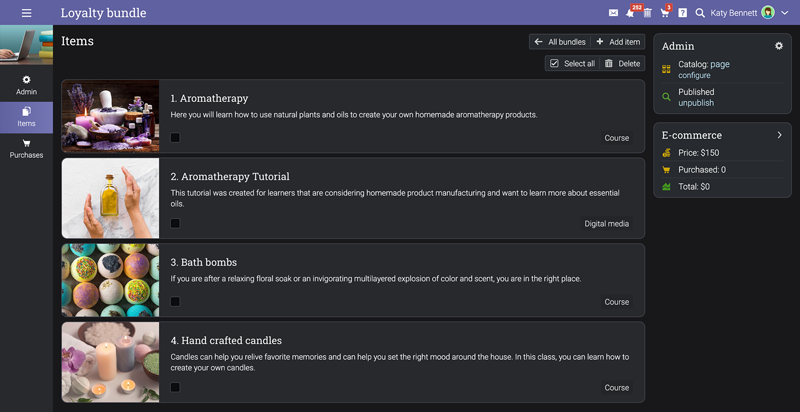
Bundles can contain only courses, digital media files such as ebooks or videos, or a mix of the two.
3. Set an amount or percentage discount
As mentioned before, you can select a percentage discount or a fixed amount. This depends on which online courses you want to create a coupon for and how many items are involved.
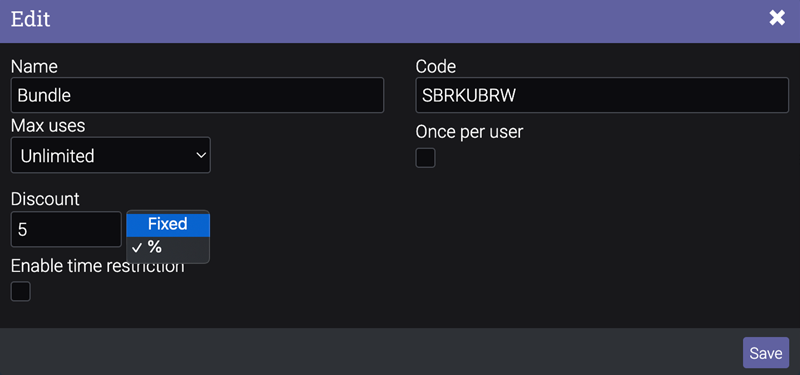
For example, let’s say you want to offer $8 off their first month for new learners that purchase a subscription plan. If the subscription is $10/month for the subsequent months, then you are essentially giving them the opportunity to sample the subscription plan for $2. If they stick with the subscription for six months, then you’ll make a total of $52/learner.
However, if you choose a percentage discount of 10% and your online course is priced at $500, then the course becomes $450, and you need to take this loss into account.
When it comes to discounting your courses, you need to think of the profit margin. If you spend, on average, $200 per learner to create a course (including costs such as marketing, editing tools, learning platform subscription, etc.) and sell it for $500, the profit margin is $300.
So, you can determine whether or not to offer a discount and the maximum discount amount, as well as how many courses you need to sell in order for the discount to make sense. Don’t forget to also take into account how many sales you need to make in order to break even if you’re planning to offer a launch coupon.
4. Create special discounts for LMS groups
Discount groups are just different learner groups that you want to either attract (new learners) or retain (loyal customers). You can also offer a coupon for different account types, such as affiliates to reward them for their efforts in promoting your courses and helping you sell more.
So, let’s say that you have created an LMS group for people who have attended your workshops. You can create a special coupon that will only work for people in this group.
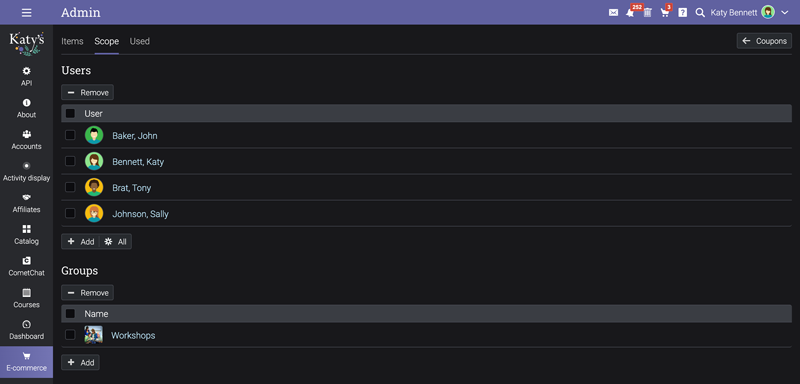
Additionally, you can host a giveaway contest to reward learners. They can enter a competition to win a 25% off coupon for any course on your platform. When you have a winner, you can simply select the learner from a list, so only they can use it.
5. Choose the currency
When setting up a new coupon, it’s ideal to add a name so it’s easy to identify later. Instead of “Coupon 1, 2, 3” you could have something more specific such as “Aromatherapy discount coupon” or “Social media coupon” that you use for your social media community, etc.
It’s also important to choose the currency that your learners are most comfortable with. Of course, it makes sense to go with the currency that you use to sell your online courses and other products.
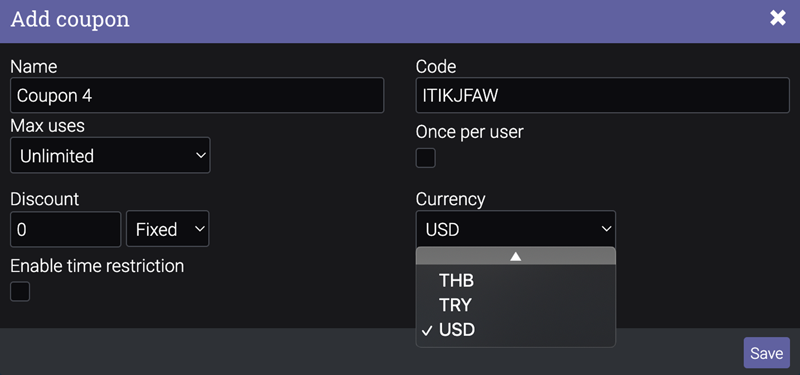
Choose the coupon currency that best suits your needs.
6. Choose a use limit
Your coupons can be used an unlimited amount of times. However, this doesn’t allow you much control over discounts, so a different approach can be limiting the total number of times a coupon can be used across all users. Think of it as the “special discount for the first 100 purchases” type of promotional tactic.
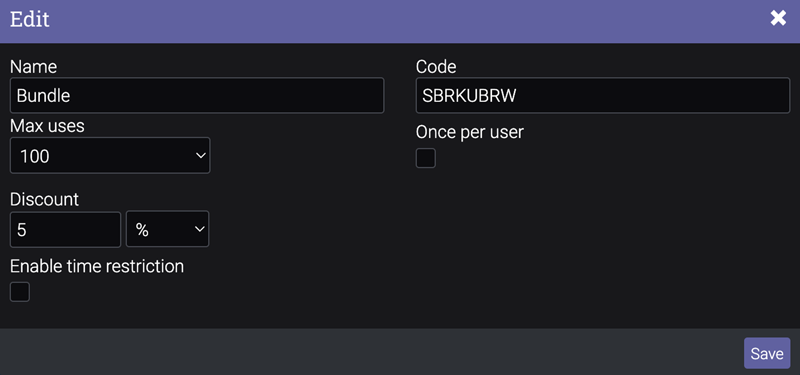
Single-use coupons are also effective as they help you retain customers and provide a sense of exclusivity as opposed to coupons that can be used multiple times. All you have to do is enable the “Once per user” option.
7. Set a time limit
By limiting the amount of time a coupon can be used, you’re basically protecting your brand and creating a feeling of exclusivity for your existing learners. This is true especially if you create a coupon to reward their loyalty.
Setting a time limit is useful when you want to create a sense of urgency and sell your courses during a certain period of time. By setting up the discount code to be used for a limited time, you might determine learners to make multiple purchases during a certain timeframe.
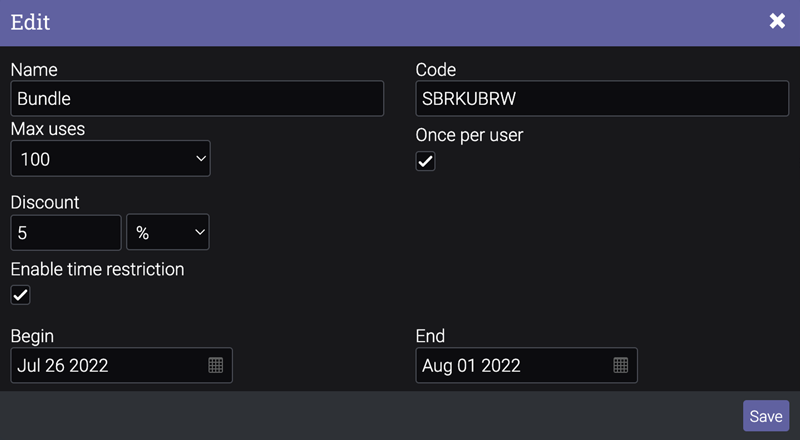
Time-sensitive coupons are a great way to convince potential learners to make a purchasing decision.
Wrapping up
Back in 1887, Coca-Cola invented the first coupon. More than a century later, you can still use the psychology behind it to make learners perceive your brand in a positive light. Now that you know how to increase your profit using discount coupons, it’s time to put your learning platform to work and generate more sales.





